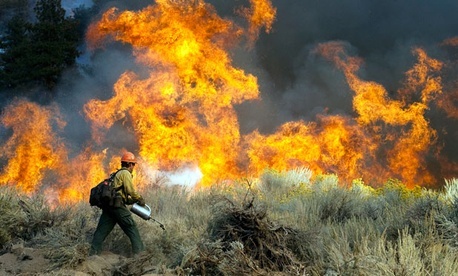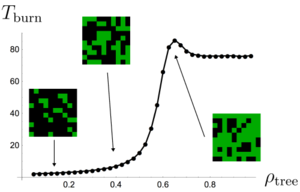An example test problem. Ignore this problem

We can be as sophisticated as we want to in measuring the dynamics of forest fire, but a quick way to gain insight is to simply keep track of how many trees are burning as a function of time (inspect for yourself to see how the number of burning trees is kept track of in the code).
 Fig 4. Fire burn time as a function of forest density.
Fig 4. Fire burn time as a function of forest density.
Our lattice is set to and is set to which means that in the absence of fire, it should take time steps to plant the entire forest. We initially set so that the probability of lightning striking a lattice point is half the probability of a tree being planted at an empty site.
Problem : How does the nature of forest fire vary as you lower the incidence of lightning strikes?
Note : While you're encouraged to play with all the parameters ( and ,) keep in mind that there is a runtime limit of
In statistical physics, this is known as a phase transition, as we can think of the value as separating two qualitatively different kinds of forest: sparsely connected forests that don't suffer large-scale wildfires, and thick forests that essentially burn to completion whenever lightning strikes.
Pattern of Powers of
The value of as it is raised to increasing integer powers follows a pattern: Multiplying by again will give and then the pattern will repeat. In general, the pattern is
Knowing this pattern means that the value of where is a positive integer, can be quickly determined. To do so, rewrite the expression to isolate the largest value of that is divisible by 4.
For example,
This section requires Javascript.
You are seeing this because something didn't load right. We suggest you, (a) try
refreshing the page, (b) enabling javascript if it is disabled on your browser and,
finally, (c)
loading the
non-javascript version of this page
. We're sorry about the hassle.
I'm testing a wonderful solution to this problem.